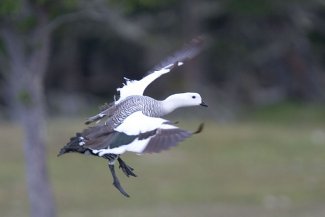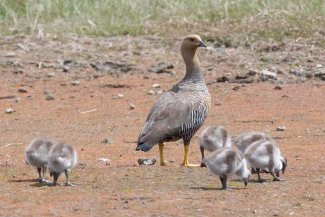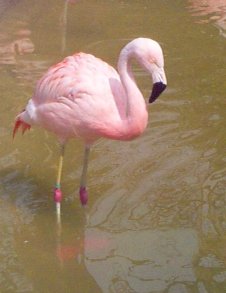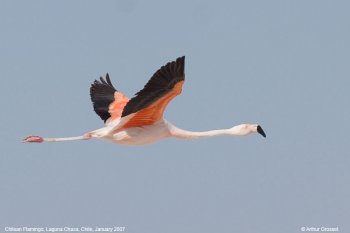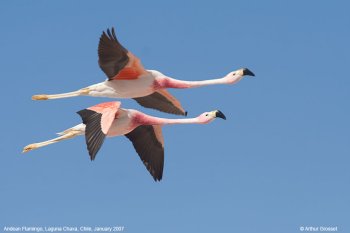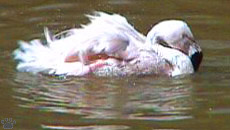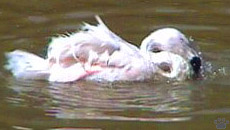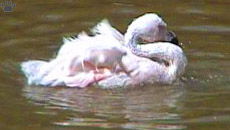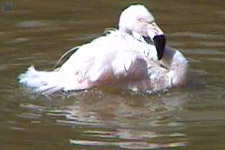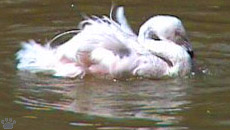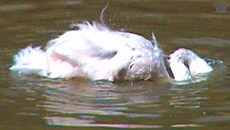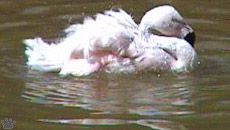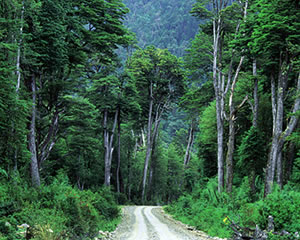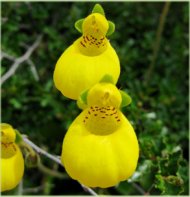|
From
a rearranged translation of Vladimir
Dinets original pages to norwegian,
with supplements.

Klikk på flagg for norsk versjon
Pages for Latin America
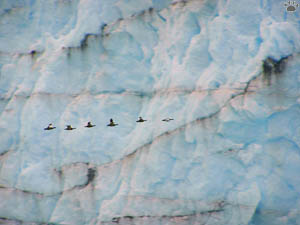 Upland
geese , Chloephaga
picta,
Upland
geese , Chloephaga
picta,
Parque Nacional Los Glaciares, Argentina. |
Patagonia
|
Andes of Patagonia are virtually uninhabited.
The highest mountains are covered with extensive icefields.
In the far south, the mountains continue to Tierra
del Fuego and the Scotia Arc.
|
 Map obtained http://www.birdtheme.org/maps/chile.jpg
Map obtained http://www.birdtheme.org/maps/chile.jpg
|
|
|
|
Views
of Cerro Fitzroy, PN Los Glaciares, Argentina.
|
 Torres
del Paine, Chile.
Torres
del Paine, Chile.
|
The eastern slope is very windy and relatively
dry, with intermontane
valleys either covered with shortgrass steppe or filled with
huge glacial
lakes. The southern part of that area is the most scenic.
Parque Nacional Torres del Paine in Chile and Parque Nacional
Los
Glaciares in Argentina have some of the world's most impressive
mountain landscapes, such is Fitzroy Range (above). Remote
and
pristine just a decade ago, these parks are now popular tourist
destinations.
|
 Clouds,
Clouds,
PN Torres del Paine.
|
|
|
|
|
|
Parque
Nacional Los Glaciares, Argentina.
|
Perito
Moreno Glacier in good weather
|
Upland
Goose, Chloephaga picta
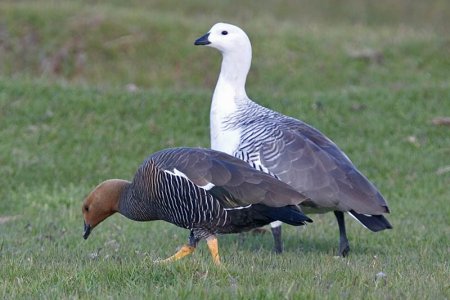 Female
Upland Goosem, male and female
Female
Upland Goosem, male and female |
The Upland Goose or Magellan Goose, Chloephaga
picta, is a South American member of the duck, goose and
swan family Anatidae.
It is in the shelduck subfamily, Tadorninae. Males have
a white head and breast, whereas the females are brown
with black-striped wings and yellow feet, and could be mistaken
for Ruddy-headed Geese. These birds are 60–72.5 centimetres
long and weigh 2.7–3.2 kilograms. They are found in open
grasslands.
Farmers look at those birds as a pest, and kill them in great
numbers, still they remain numerous. |
Perito Moreno in PN Los Glaciares is now the most visited glacier
in South America.
|
|
|
|
Perito
Moreno Glacier in bad weather.
|
Perito
Moreno Glacier in good weather.
|
This glacier is easily accessible. It's also very active.
Small-scale calving can usually be seen every hour or two; larger
icebergs break off at least once a day.
|
|
|
|
Perito
Moreno Glacier flows from the South Patagonian Icefield.
|

Perito Moreno Glacier enters the forest
in some years. |

Alfa male guanaco on a lookout.
PN Los Glaciares |
Cougar,
Felis concolor

Torres
del Paine National Park
Photo: © Willam
L Franklin, National Geographic, January 1991 |
The Cougar, Felis concolor, is not an animal you should get too near,
at least not on a hillside like this.
The Cougar, Felis concolor, is not
an animal you should get too near, at least not on a hillside
like this.
The cougar, also known as puma, mountain lion, mountain cat,
catamount or panther, depending on the region, is a mammal
of the family Felidae, native to the Americas. This
large, solitary cat has the greatest range of any large wild
terrestrial
mammal in the Western Hemisphere, extending from Yukon in
Canada to the southern Andes of South America.
An adaptable, generalist species, the cougar is found in every
major American habitat type. It is the second heaviest cat
in
the Western Hemisphere, after the jaguar.
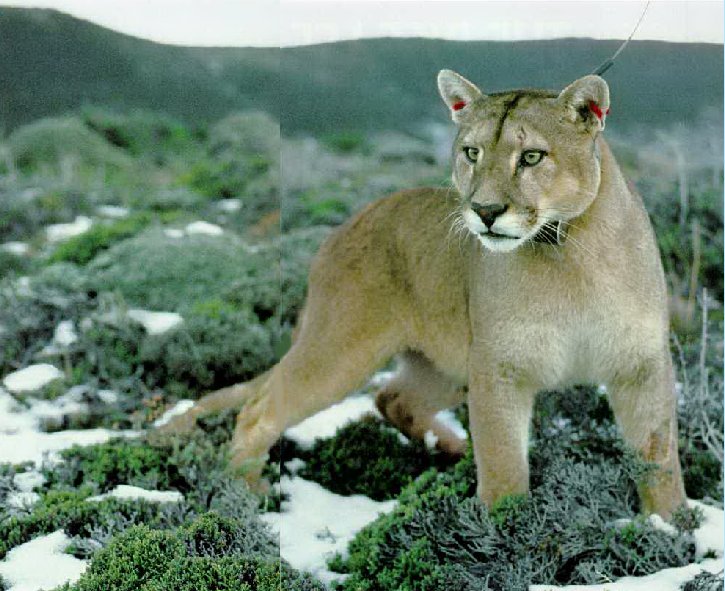
Notice
the antenna on the left ear. Scientists are still
trying to learn about this animal.
Torres del Paine National Park
Photo: © Willam
L Franklin, National Geographic, January 1991 |
A capable stalk-and-ambush predator, the cougar pursues a
wide variety of prey. Primary food sources include ungulates
such as deer, elk, moose, and bighorn
sheep, as well as domestic cattle, horses and sheep, particularly
in the northern part
of its range. In its southern range it include fish, birds,
(i.e. the Nanduen,
Rhea
pennata,
which can not fly), mouse,
Lamas, Guanoacos, foxes and many others.
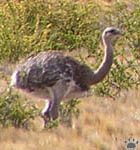
Darwin's Rhea,
Rhea pennata |
It will also hunt species as small as insects and rodents.
This cat prefers habitats with dense underbrush and
rocky areas for stalking, but it can also live in open areas.
The cougar is territorial and persists at low population densities.
Individual territory sizes depend on terrain, vegetation,
and abundance of prey.
While it is a large predator, it is not always the dominant
species in its range, as when it competes for prey with other
predators such as the jaguar, grey wolf, American Black Bear,
and the grizzly bear. It is a reclusive cat and usually avoids
people. Attacks on humans remain fairly rare, despite a recent
increase in frequency.
Source: http://en.wikipedia.org/wiki/Cougar
|
More
about the Cougar - click here
Darwin's
Rhea, Rhea pennata

Darwin's Rhea in Patagonia, Chile |
Darwin's Rhea, Rhea pennata, also known as the Lesser
Rhea or Nandu, is a large flightless bird, but the smaller of
the two extant
species of rheas. It is found in the Altiplano and Patagonia
in South America.
It stands at 90–100 cm tall and weighs 15–25 kg, and
has larger wings than other ratites, enabling it to run particularly
well.
It can reach speeds of 60 km/h, enabling it to outrun predators.
The sharp claws on the toes are effective weapons.
Their plumage is spotted brown and white, and the upper part
of their tarsus is feathered.
The males of this species become aggressive once they are incubating
eggs. The females thus lay the later eggs near the nest, rather
than
in it. Most of the eggs are moved into the nest by the male,
but some remain outside, where they rot and attract flies. The
male,
and later the chicks, eat these flies. The incubation period
is 30–44 days, and the clutch size is from 5–55 eggs.
The eggs are 87–126 mm and are greenish yellow. Outside
the breeding season, Darwin's Rhea is quite sociable: it lives
in groups
of from 5 to 30 birds, of both sexes and a variety of ages.
 Lesser
rhea chicks with adults
Lesser
rhea chicks with adults
BBC
Natural History Unit
www.arkive.org
|
Darwin's Rhea lives in areas of open scrub in the grasslands
of Patagonia and on the Andean plateau (the Altiplano), through
the
countries of Argentina, Bolivia, Chile, and Peru. It is known
locally by various names, depending on the location: For example
suri, choique, ñandú petiso, or ñandú
del norte. The name 'ñandú' comes from the bird's
name in Guaraní ñandú guazu, meaning big
spider,
posibly in relation to their habit of opening and lowering alternatively
wings when they run. All subspecies prefer grasslands, brushlands
and marshland. However the nominate subspecies prefers elevations
less than 1,500 m, where the other subspecies typically range
from 3,000–4,500 m, but locally down to 1,500 m in the
south.
Source: http://en.wikipedia.org/wiki/Darwin's_Rhea |
Guanaco,
Lama guanicoe
 A
guanaco, Lama guanicoe, is being borned, with legs
first.
A
guanaco, Lama guanicoe, is being borned, with legs
first.
The Guanacos make up 55% of the food for the Cougar,
Torres del Paine National Park
Photo:
© Willam
L Franklin, National Geographic, January 1991 |
The guanaco, Lama guanicoe, is a camelid native
to South America that stands between 107 and 122 cm at the shoulder
and weighs about 90 kg. The colour varies very little (unlike
the domestic llama), ranging from a light brown to dark cinnamon
and
shading to white underneath. Guanacos have grey faces and small
straight ears. The name guanaco comes from the South
American language Quechua word wanaku (old spelling, huanaco).
Young guanacos are called chulengo(s).
The guanaco is native to the arid, mountainous regions of South
America. Guanaco are found in the altiplano of Peru, Bolivia,
Ecuador, Colombia, Chile and Argentina. In Chile and Argentina,
they are more numerous in Patagonian regions, in places like
the Torres del Paine National Park, and Isla Grande de
Tierra del Fuego. In these areas, they have more robust populations,
since there are limitations on grazing competition from livestock.
Bolivian Indians have been known to raise guanaco to help
them regain their population stability. A guanaco’s typical
lifespan is 20 to 25 years.
Estimates, as of 2011, place their numbers at 400,000 to 600,000.
 Guanaco
herd feeding, juveniles play-fight;
Guanaco
herd feeding, juveniles play-fight;
guanaco grazes and shelters during a snowstorm
BBC Natural
History Unit
http://www.arkive.org
|
Guanaco live in herds composed of females, their young and a
dominant male. Bachelor males form a separate herd.
While female groups tend to remain small, often containing no
more than ten adults, bachelor herds may contain as many
as 50 males. When they feel threatened, guanaco alert the herd
to flee with a high-pitched bleating call. The male will usually
run behind the herd to defend them. They can run with a speed
of 56 km per hour, often over steep and rocky terrain.
They are also excellent swimmers. The guanaco have an unusual
method of survival - licking all the nutrients and dew from
desert cacti.
Guanacos are one of the largest wild mammal species found in
South America (along with the manatee, the tapir,
and
the jaguar). . They have only one natural predator, the
mountain lion. Guanacos will often spit when threatened.
To protect its neck from harm, the guanaco has thicker skin
on its neck, a trait still found in its domestic counterparts,
the llama and alpaca, and its wild cousin, the vicuña.
Bolivians use the necks of these animals to make shoes, flattening
and pounding the skin to be used for the soles.
Source: http://en.wikipedia.org/wiki/Guanaco
As so many other animals,
the guanaco also cooperates with another creature to avoid dangers
and threets. Is works
closely with the Nandu (Lesser Rhea), which has a very sharp
eyeview, so combined with its own well delevoped sence
of smell and good hearing, make them together a first class
alarm-system. |
Andean foothills have plenty of wildlife, such as guanacos, pumas
and huge concentrations of birds,
especially around small lakes. In winter some wildlife is easier to
see, but the weather can be brutal.
Chilean
Flamingo, Phoenicopterus chilensis

Chilean flamingos
Phoenicopterus chilensis,
PN Los Glaciares. |
|

Chilean flamingos
Phoenicopterus chilensis,
PN Los Glaciares. |
There are many shallow saltlakes up in the mountains. That is why
most bird stay away from them.
The exception is the flamingos. Here you can find the Andean Flamingo,
Puna Flamingo and
Chilean Flamingo, Phoenicopterus chilensis.
|
|
|
Chilean
Flamingo, Flamenco chileno, (left) Note the grey legs
with the red joints and feet.
Compare with Andean Flamingo, Phoenicoparrus andinus,
(right) with yellow feet.
They are often seen at the same Andean sites
Photo:
© http://www.arthurgrosset.com
|
The Chilean Flamingo, Phoenicopterus chilensis,
is a large species, 110–130 cm.
It breeds in temperate South America from Ecuador and Peru to
Chile and Argentina and east to Brazil.
Like all flamingos it lays a single chalky white egg on a mud
mound.
The plumage is pinker than the slightly larger Greater Flamingo,
but less so than Caribbean Flamingo. It can be differentiated
from these species by its greyish legs with pink "knees",
and also by the larger amount of black on the bill (more than
half).
Young chicks may have no sign of pink coloring whatsoever, but
instead remain grey.
The Chilean flamingo's bill is equipped with comb-like structures
that enable it to filter food—mainly algae and plankton—
from the water of the coastal mudflats, estuaries, lagoons and
salt lakes where it lives.
Source: http://en.wikipedia.org/wiki/Chilean_Flamingo
 Chilean
flamingo, Phoenicopterus chilensis - overview
Chilean
flamingo, Phoenicopterus chilensis - overview
BBC
Natural History Unit
http://www.arkive.org
|
When the salar is covered with water, three species of flamingo
use it for nesting.
The most common is Chilean flamingo,
found here in flocks of thousands.
The birds feed on single-cell algae that grow rapidly
|
|
When
the salar is dry, the flamingo flocks move elsewhere,
but flocks of varying size can usually be found at smaller
lakes nearby, especially at Salar de Coipasa to the
north, a huge salt flat that always has water in the
center.
|
|
The Andean Flamingo, Phoenicopterus andinus, is
one of the rarest flamingos in the world. It has a pale pink
body with
brighter upperparts, deep vinaceous-pink lower neck, breast,
and wing-coverts. It is the only flamingo species with yellow
legs
and three-toed feet. The bill of the Andean Flamingo is pale
yellow and black. This flamingo is native to the wetlands of
the high
Andes mountain range from southern Perú to northwestern
Argentina and northern Chile. The Andean Flamingo is a migratory
bird with the ability to travel up to 1.100 km(?) in one day.
These flamingos are filter-feeders and their diet ranges over
the
entire spectrum of available foods, from fish to invertebrates,
from vascular plants to microscopic algae.
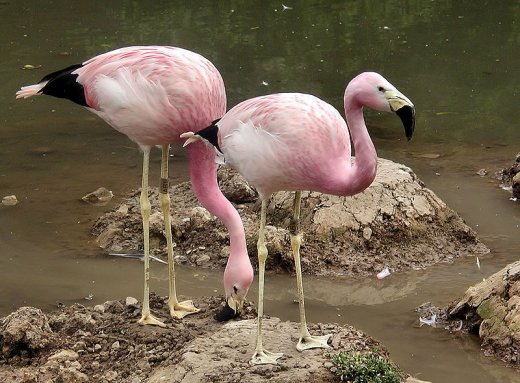 Andean
Flamingos, Phoenicopterus andinus
Andean
Flamingos, Phoenicopterus andinus
at Slimbridge Wildfowl and Wetlands Centre, Gloucestershire,
England.
http://en.wikipedia.org/wiki/File:Two_andeanflamingo_june2003_arp.jpg
|
Andean flamingos feed from the bottom layer of the lake for
small particles, mainly diatoms. Andean Flamingos have a deep-
keeled bill; the upper jaw is narrower than the lower jaw and
this creates a gape on the dorsal surface of the bill.
The Andean Flamingo’s bill morphology creates a feeding
mechanism that aids in their feeding of diatoms called inertial
impaction. This mechanism entails that food particles denser
than water, such as diatoms, would impact the filtering surface
in the bill causing water to flow out of the mouth and leaving
diatoms in the flamingo’s bill.
In the summer, Andean Flamingos live in salt lakes and migrate
to the lower wetlands for the winter. The cause of this migration
from summer to winter is possibly due to the extreme aridity
of salt-flats during the winter. The path of migration
is unknown,
but it is thought to occur between the Chilean breeding grounds
and the wetlands of central and western Argentina.
Source: http://en.wikipedia.org/wiki/Andean_Flamingo
James's Flamingo, Phoenicoparrus jamesi, is also
known as the Puna Flamingo. It populates the high altitudes
of Andean
plateaus of Peru, Chile, Bolivia and Argentina. It is closely
related to the Andean Flamingo, and the two make up the genus
Phoenicoparrus. The Chilean flamingo, Andean flamingo
and James's flamingo are all sympatric, and all live as a colony
(including shared nesting areas). The James flamingo was thought
to have been extinct until a remote population was
discovered in 1956.
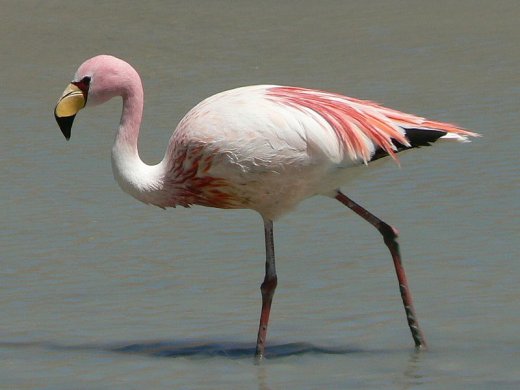 James's
Flamingo, Phoenicopterus jamesi
James's
Flamingo, Phoenicopterus jamesi
Photo: Iain and Sarah
http://en.wikipedia.org/wiki/File:James_Flamingo.jpg
|
The James's Flamingo have a very long neck that is made up of
19 long cervical vertebrae allowing for a lot of movement and
rotation of the head. Their long thin legs also characterize
them. The knee is not visible externally but is located at the
top of the
leg. The joint at the middle of the leg, which most assume to
be the knee joint is actually the ankle joint. Its plumage is
very pale
pink, with bright carmine streaks around the neck and on the
back. When perched a small amount of black can be seen in the
wings, these are the flight feathers. There is bright red skin
around the eyes, which are yellow in adults. The legs are brick
red
and the bill is bright yellow with a black tip.
Source: http://en.wikipedia.org/wiki/James's_Flamingo
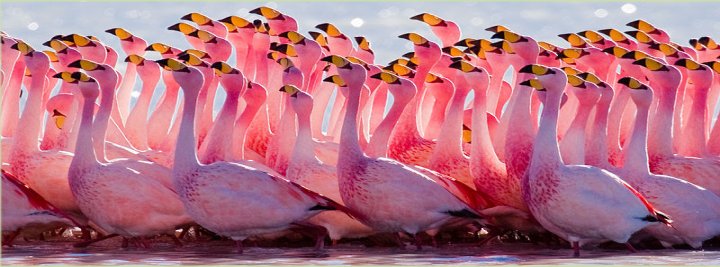 Mating
Ritual: James's Flamingo
Mating
Ritual: James's Flamingo
Photo: Pedros Szekely
http://en.wikipedia.org/wiki/File:James%27s_Flamingo_mating_ritual.jpg
|
|
and that ends up the Flamingos.
The western side of Patagonian Andes is no less scenic, but seldom
visited. It is a labyrynth of fjords, islands,
and channels, with slopes covered by dense temperate rainforests,
mostly of southern beech (Notofagus).
It can be accessed by Puerto Montt-Puerto Natales ferry, or by
Carretera Austral,
one of the most beautiful and remote highways in the world.
Most of the region is now protected by a network of huge, very pristine
National parks.
 Rainbow
over Carretera
Rainbow
over Carretera
Austral in Parque
Nacional Queluat. |
|
 Unidentified
flower,
Unidentified
flower,
Carretera Austral in
PN Queluat. |
| |
http://www.puyuhuapilodgespa.com/travel-chile-patagonia-esp/paginas/carreteraaustral.html#
|
|
The first section of the Carretera Austral , moves along the
Seno Reloncaví from Puerto Montt to Chaiten , which covers
approx. 220 km between fjords and forests. Highlights include
the Alerce Andino National Park with ancient larch forests,
the age of some of these native trees over 3 thousand years,
and Pumalin Park, in charge of the Foundation of the same
name and directed by American Douglas Tomkins, offering beautiful
trails through the extraordinary landscape of this region.
It is also possible to sail to visit a colony of sea lions.
Pumalin Park is accessed after a ferry crossing from Hornopirén
to
Caleta Gonzalo |
This area has a lot of endemic plants, most of them survivors of
ancient Antarctic flora.
Parasitic plants are especially diverse. Wildlife includes two endemic
species of deer,
numerous rodents, and some little-known predators such as Patagonian
weasel, Lyncodon patagonicus.
Patagonian
Weasel, Lyncodon patagonicus
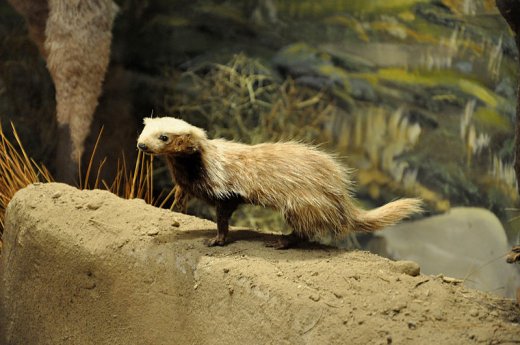 Patagonian
Weasel - Museum of Patagonia - San Carlos de Bariloche Argentina
Patagonian
Weasel - Museum of Patagonia - San Carlos de Bariloche Argentina
Photo: Serge
Ouachée
|
The Patagonian Weasel, Lyncodon patagonicus,
is a small mustelid that is the only member of the genus Lyncodon.
Its geographic range is the Pampas of western Argentina and
sections of Chile. An early mention of the animal is in the
Journal of Syms Covington, who sailed with Charles Darwin on
his epic voyage aboard the HMS Beagle.
The Patagonian Weasel has a head and body length of 300-350
mm, with a 60–90 mm tail. Its fur is whitish with black
and dark brown tones mixed in. It has small ears, short legs
and a bushy tail. The animal has not been thoroughly studied
in the wild, and knowledge of its behavioral patterns is unsure.
It reportedly has been kept as a working pet by local
ranchers to destroy rodents. |
Southern
River Otter, Lontra provocax
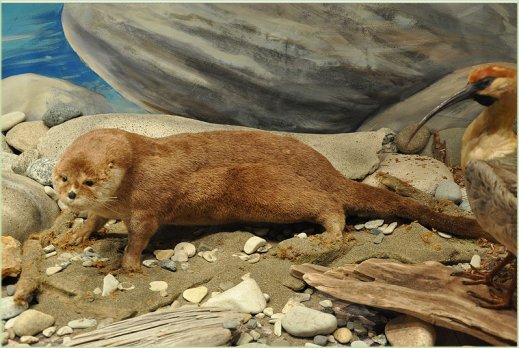 Southern
River Otter, Lontra provocax,
Southern
River Otter, Lontra provocax,
Museum of Patagonia - San Carlos de Bariloche, Argentina
Photo: Serge
Ouachée
|
The Southern River Otter, Lontra provocax, is
a species of otter that lives in Chile and Argentina. Although
called a "river otter", it inhabits both marine and
freshwater environments.This is a subspecies of Lontra canadensis.
The southern river otter is listed as endangered, due to illegal
hunting, water pollution, and habitat loss.
This medium-sized otter's body can grow up to 70 cm long, with
a tail adding about 40 cm. Body weight averages
at about 5-10 kg. Its skin is dark-brown on the top and has
a lighter cinnamon color on its underside.
Although the female and her young will live in family groups,
males are usually solitary. Litter sizes average one to
two pups, but up to four can be born at a time. Their diet includes
fish, crustaceans, mollusks, and birds.
The southern river otter can be found in marine, freshwater,
and terrestrial habitats, but are mostly found in
freshwater lakes and rivers. Having a significant amount of
dense vegetation, especially along the shorelines, must
be present to use as cover. Their habitat also needs the root
systems of mature trees, as well as fallen tree debris.
http://en.wikipedia.org/wiki/Southern_river_otter
|
Magellanic
Woodpecker, Campephilus magellanicus
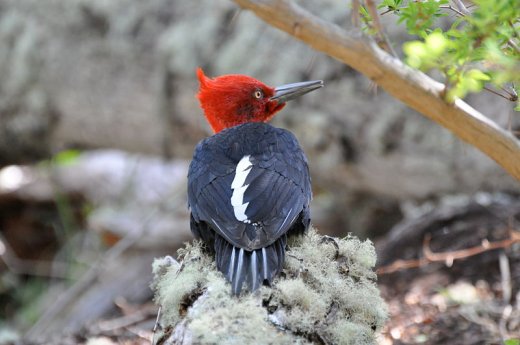
Magellanic
Woodpecker Male, Campephilus
magellanicus,
National Park of Tierra del Fuego, Tierra del Fuego, Argentina
Photo: Serge Ouachée
|
The Magellanic Woodpecker, Campephilus
magellanicus, is a very large woodpecker found along
the Andes of Chile
and southwestern Argentina; it is resident within its range.
This species is the southern-most example of the genus Campephilus,
which includes the famous Ivory-billed Woodpecker.
The Magellanic Woodpecker is 45 cm in length. Males of this
species weigh 310-365 g, and females weigh 275-310 g.
They are the largest South American woodpeckers and one of
the largest woodpeckers in the world (Black Woodpeckers and
Great Slaty Woodpeckers are the only larger extant species).
 Magellanic
Woodpecker Female, Campephilus
magellanicus,
Magellanic
Woodpecker Female, Campephilus
magellanicus,
National Park of Tierra del Fuego, Tierra del Fuego,
Argentina
Photo: Serge
Ouachée
|
This species is mainly black, with a white wing patch and
a grey, chisel-like beak. Males have a crimson head and crest.
Females have a mainly black head, but there is an area of
red coloration near the base of the bill. Juvenile Magellanic
Woodpeckers resemble females of the species, but have a smaller
crest and are browner in color. In its range, this bird is
unmistakable in appearance.
Magellanic Woodpeckers inhabit mature Nothofagus and Nothofagus-Austrocedrus
forests, where they feed mainly on
grubs and adult beetles, but also on small reptiles. They
breed in late fall to early winter, digging a nest cavity
5-15m
above the ground. Females lay 1-4 eggs.
Source:
http://en.wikipedia.org/wiki/Magellanic_Woodpecker
|
Slipper
flower, Calceolaria L
Lily of the Incas, Alstroemeria
|
|
|
|
The most famous flowers of Chile include 12 species of Calceolaria
(left) and 35 species of Alstroermia (right, with Brachysternus
beetle). Isla Chiloe.
|
Slipper flower, Calceolaria
L. also called Lady's purse and Pocketbook flower or
Slipperwort, is a genus of plants in the Calceolariaceae
family, sometimes classified in Scrophulariaceae by some
authors. This genus consists of about 388
species of shrubs, lianas and herbs, and the geographic range
extends from Patagonia to central Mexico, with its distribution
centre in Andean region. Calceolaria in Latin means shoemaker.
Calceolarias have usually yellow or orange flowers, which can
have red or purple spots.
Source: http://en.wikipedia.org/wiki/Calceolaria |
|
Lily of the Incas, Alstroemeria, or commonly
called the Peruvian Lily Lily of the Incas, is a South American
genus of about
120 species of flowering plants. Almost all of the species are
restricted to one of two distinct centers of diversity, one
in central
Chile, the other in eastern Brazil. Species of Alstroemeria
from Chile are winter-growing plants while those of Brazil are
summer-
growing. All are long-lived perennials except A. (Taltalia)
graminea, a diminutive annual from the Atacama Desert of
Chile.
Source:
http://en.wikipedia.org/wiki/Alstroemeria |
Many parts of the region have never been explored thoroughly.
If there is a place on Earth where you might still hope to find dinosaurs,
it's probably the remote valleys of Southern Chile.
Cold-resistant dinosaurs have lived there in the past; other "living
fossils" are still present.

Notophagus forest,
Parque Nacional Queluat. |

Edge of Perito Moreno Glacier forms a tiny ice shelf.
|

Hanging Glacier, Parque Nacional Queluat .
|
 Perito
Moreno Glacier
Perito
Moreno Glacier |
Its going to get even colder on the next page
Part 4. Tierra del Fuego
Back to Part 2
All
pictures, unless otherwise stated, Copyright © Vladimir
Dinets
|












